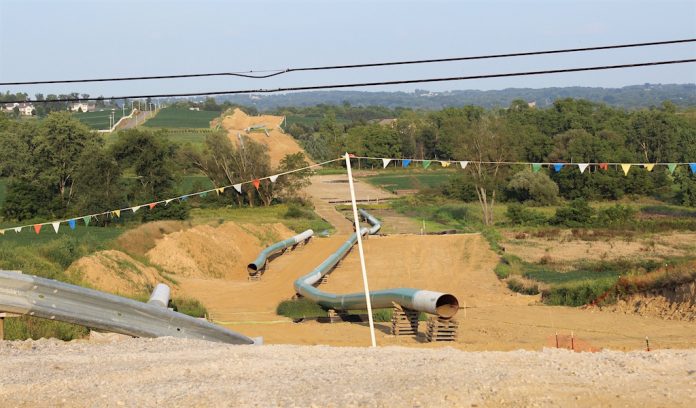WOOSTER, Ohio — As pipeline construction continues — and even nears completion in some counties — landowners need to pay attention to the impacts on their soil and what kind of remediation will be needed.
Just last week, the Rover pipeline received federal approval to put the first phase of its natural gas pipeline into service, and other energy companies are also making strides to get their lines in operation.
During a meeting Aug. 29 at the Agricultural Technical Institute in Wooster, experts with Ohio State University Extension and the Wayne Soil and Water Conservation District said they have heard from a wide range of landowners with varying experiences — both positive and negative — about their satisfaction with the reclamation process.
The session was led by OSU Extension Wayne County, as well as OSU soil fertility specialist Steve Culman; Adam Liston, of Wayne SWCD; and John Knapp, of Wayne County’s USDA Natural Resource Conservation Service office.
The speakers outlined a number of things landowners should do, and they also encouraged landowners to take part in a soil study being led by OSU researchers.
- • •
- Keep an eye on the work and the worker. You may not be able to watch everything that gets done, but having the workers know you’re interested and concerned about what they’re doing could work to your benefit. Be mindful about your own safety and the safety of those around you, but communicating with project leaders is a valuable way of keeping them accountable and making sure both parties have the same understanding.
2. Make sure your easement and soil reclamation contracts are complete. If you’re still working on an easement, make sure you’ve had it reviewed by an attorney, and soil and fertility experts and that it covers everything you need to restore your soil to favorable growing conditions. Yield losses can continue for multiple years, depending on how long it takes to rebuild the organic matter and fertility of your soil. You need to think both short- and long-term.
- Avoid and mitigate compaction. As Culman pointed out, the best way to handle compaction is to prevent it in the first place. This means not driving over excessively wet soils and limiting the use of heavy equipment. There are many ways to help alleviate compacted soil, but compaction can take years to overcome. One method is deep ripping and certain controlled types of tillage. You can also add organic matter, including various mulch materials. Other methods include crops with deep root structures, and adding soil amendments like gypsum.
- Bring back the fertility. In addition to alleviating compaction, you should have your soil tested to determine its fertility needs and add organic matter and fertilizer accordingly. You might also consider reducing or eliminating tillage for a period of years to build soil structure, aggregates and porosity. A long-term perennial crop like alfalfa or clover and grasses could provide a natural way of improving your soil health.
- Get bare ground covered. It’s never a good idea to leave your ground uncovered — especially with winter coming. There are dozens of cover crops that can be used, but you need to select a variety that will do well in your soil type and that will satisfy your expectations. Charts are available to help you compare different crops. You need to consider the heat, drought, shade, flood and fertility tolerances of different crops, and what exactly you want the crops to do — whether it’s build soil, fight erosion, fight weeds, provide for grazing — or all of these things.
- Get a good start. After you’ve decided on what type of crop or vegetation to plant, make sure your seed bed is properly prepared. All tree limbs, boulders, rocks and anything else exposed during the pipeline project should be removed. Make sure your seed is a high quality brand and free of noxious weeds. Choose a seeding and planting schedule that assures proper establishment, and add as much chopped straw or mulch as possible.
- Get in touch. OSU Extension, as well the SWCD and NRCS offices, all have information available in each county to help direct your decisions. You can visit their websites or contact your local Extension agent or soil conservation technician. You may also be able to participate in an OSU-led study of pipeline-affected soils by contacting a team member and volunteering your farm. The study will compare pipeline-affected soil to adjacent, non-affected soils and provide landowners with soil health and comparison data over a period of three to four years.
(To learn more about the OSU pipeline soil study, visit go.osu.edu/pipeline-signup, or contact Steve Culman at culman2@osu.edu, or call 330-822-3787. You can also contact your local SWCD or NRCS office for more information.)











Good luck with that! Here’s the true story about pipelines and farmland. Pipelines and Farmers Battle Over Lifetime Loss https://www.agweb.com/mobile/article/pipelines-and-farmers-battle-over-lifetime-loss-naa-chris-bennett/
It’s interesting that you mentioned we should keep an eye on the workers so they see we’re interested in what they’re doing. My brother is going to have some pipelines installed and this is a great tip so that everything turns out as planned. I’ll share this article with him so he can now what to do after they install the pipelines.